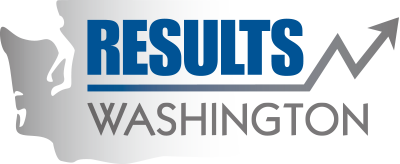Archived: State and Locally Owned Bridges
The condition of bridges on the National Highway (NHS) measured by bridge deck area is shownabove. The percent of bridge deck area in poor condition is shown separatelyfor bridges that are owned and managed by Washington state and for those ownedand managed by local agencies (cities and counties). The Washington StateDepartment of Transportation (WSDOT) manages state-owned bridges and isresponsible for their maintenance and preservation. Local agencies areresponsible for maintaining and preserving locally-owned bridges. WSDOT andlocal agencies use the same criteria to inspect the condition of bridges;therefore bridge ratings are consistent for state and locally-owned bridges.
Bridges are afoundation of economic growth in our state and are vital links to keep peopleand goods moving. Bridges on the NHS are of particular importance because theyare part of a network of strategic highways within the United States servingmajor airports, ports, defense facilities, rail and/or truck terminals andother transport facilities. All bridges in Washington are designed, constructedand maintained with the primary goal of the safety of the traveling public.Additional considerations include bridge longevity, contributions to thecommunity and regional economic vitality. Bridges can serve the travelingpublic for more than 100 years if preserved and maintained effectivelythroughout their lifespan. Maximizing the useful service life of bridges keepsthem safe and serves the public for the least cost to taxpayers.
In 2017, 8.9% ofstate-owned bridges by deck area and 5.7% of local agency-owned bridges by deckarea on the NHS were in poor condition. The percent of WSDOT bridge deck areain poor condition decreased from 9.2% in 2016, and the percent of local agencybridge deck area in poor condition decreased from 10.0% in 2016.
Measuring bridgeconditions by deck area provides a more comprehensive picture of system-wideconditions than only counting the number of bridges. For example, in 2017 106(4.7%) of the 2,272 WSDOT-owned bridges on the NHS were in poor condition, butreporting that figure alone would cause readers to underestimate the need forbridge repairs. Reporting bridge conditions by deck area makes it clear that8.9% of WSDOT’s bridge assets on the NHS are in poor condition.
The recently passedConnecting Washington transportation funding package will designate funding tohelp address the most critical needs on the state's bridges. As part of the $16billion transportation revenue package, $1.2 billion is allocated to statehighway preservation, which includes maintaining bridges, pavement and trafficoperations. WSDOT is working to identify bridge preservation projects as partof this investment. Three specific bridge projects were identified as a part ofthe $1.2 billion to be addressed in the next six years:
SR 241 Yakima River bridge near Mabton - $12 million
US 12 Wildcat Creek bridge near White Pass - $12 million
SR 107 Chehalis River bridge near Montesano - $12.5 million
In addition to the $1.2billion, another $57.5 million from Connecting Washington is allocatedspecifically to bridge preservation and repair projects over the next 16 years.No specific projects have been identified as part of this investment.
Connecting Washingtonfunding will not allow WSDOT to restore all of its structurally deficientbridges to fair or better condition. Structurally deficient does not mean thatthe bridge is unsafe or in need of replacement; typically, one or more of astructurally deficient bridge’s components requires either repair orpreservation. Using a lowest lifecycle costs approach to deliveringpreservation strategies means that there will continue to be bridge componentsthat need work.
To support and advise localagencies on bridge needs, WSDOT funds and administers the Local Federal BridgeProgram, which provides funds to local agencies to preserve and improve theconditions of city and county bridges that are physically deteriorated orstructurally deficient. This program may fund bridge replacements or bridgerehabilitation and preservation projects such as scour repair, painting,seismic retrofit, deck overlay or joint replacement. In the fall of 2017, theLocal Federal Bridge Program awarded a total of $72.9 million to 37 projects,which were selected from applications received in response to the programs mostrecent call for projects
- Replacing deteriorated bridge elements: WSDOT performs major preservation repairs by addressing specific bridge elements (such as floating bridge anchor cables, expansion joints and concrete columns) to improve a bridge with a low condition rating.
- Repainting steel bridges: A protective paint coating on a steel bridge is essential to prevent corrosion,extend the bridge’s service life and keep the bridge in fair or better condition. Continuing to keep up with painting can prevent the number of bridges in poor condition from increasing.
- Repairing concrete bridge decks: WSDOT is working to reduce the number of bridges classified as structurally deficient by addressing bridges with the highest benefits and the most cost savings. One strategy to do so is to repair and rehabilitate concrete bridge decks to extend their service life.
For additional information about the condition of the state’s bridges and the actions WSDOT is taking to maintain and preserve bridges today and for the future, see WSDOT’s quarterly accountability report, the Gray Notebook 66 , pp. 17-27, at
http://wsdot.wa.gov/publications/fulltext/graynotebook/Jun17.pdf#page=17
Learn more about WSDOT’s Bridge Program at http://www.wsdot.wa.gov/Bridge/Structures/ and learn more about WSDOT’s Local Bridge Program at http://www.wsdot.wa.gov/LocalPrograms/Bridge/Funding.htm.
Contact the following boards and organizations for ways to get more involved:
Transportation Improvement Board (TIB)
County Road Administration Board (CRAB)
Washington State Association of Counties (WSAC)
Association of Washington Cities (AWC)
